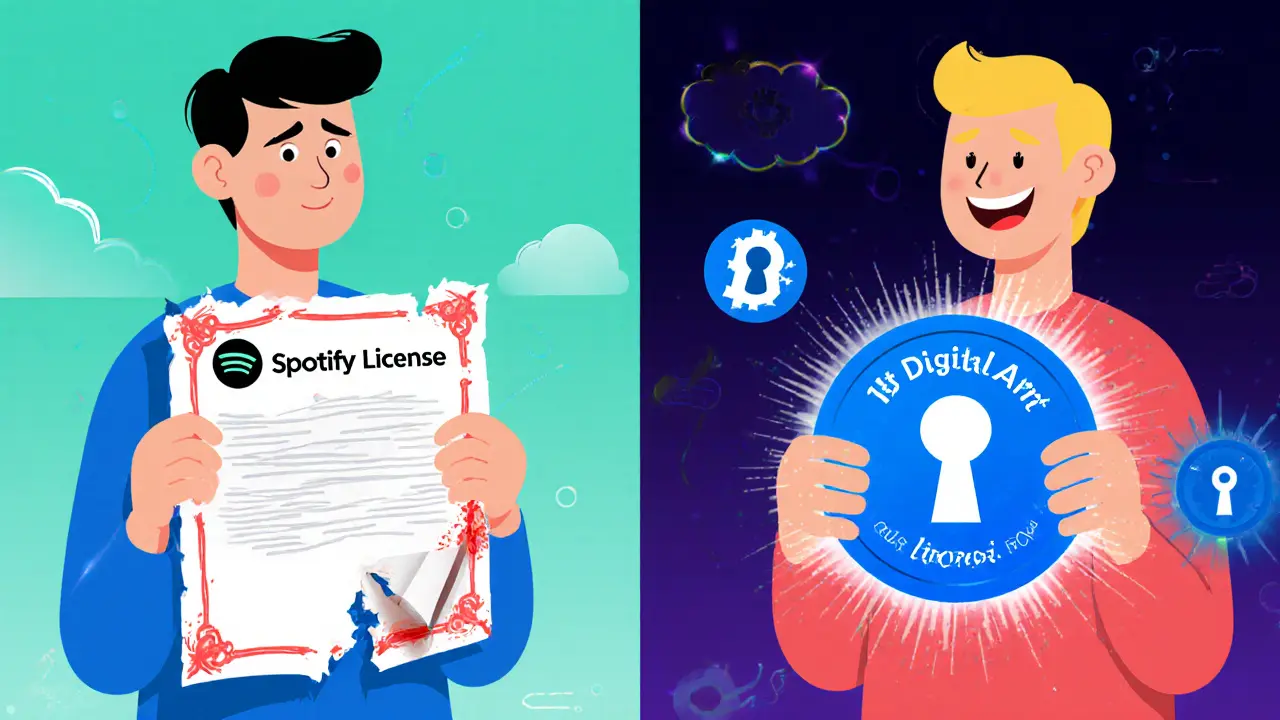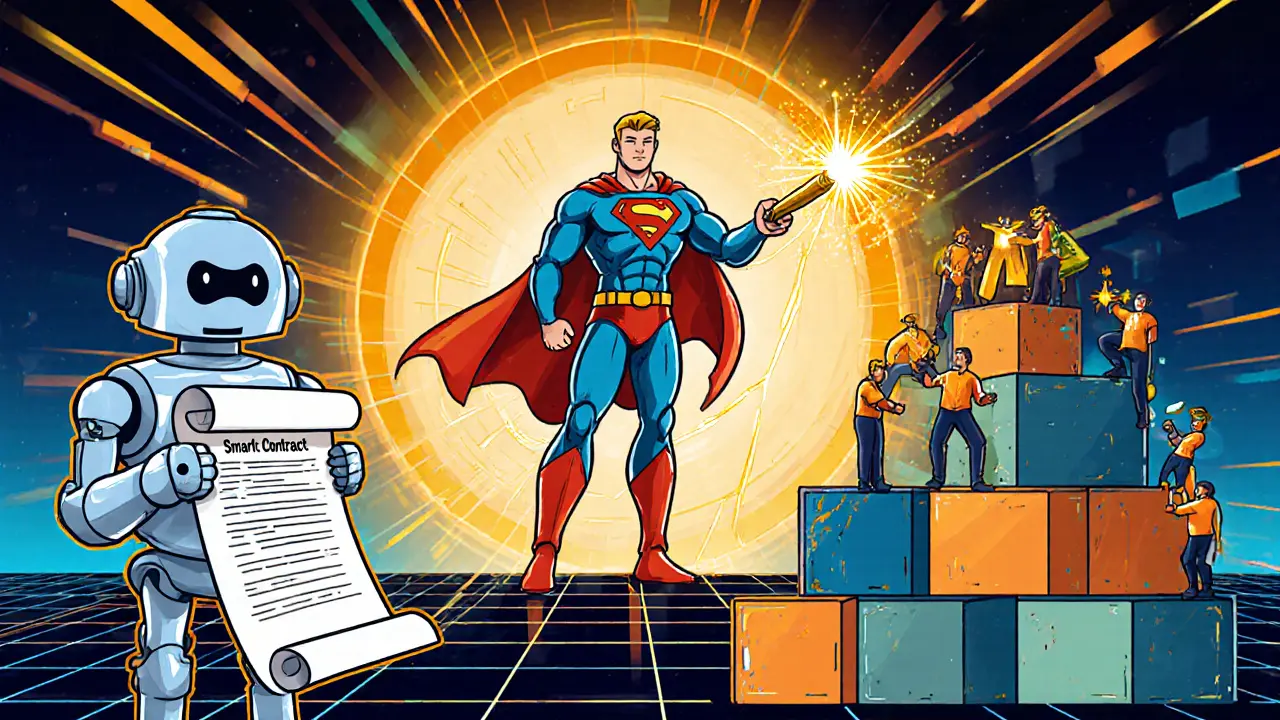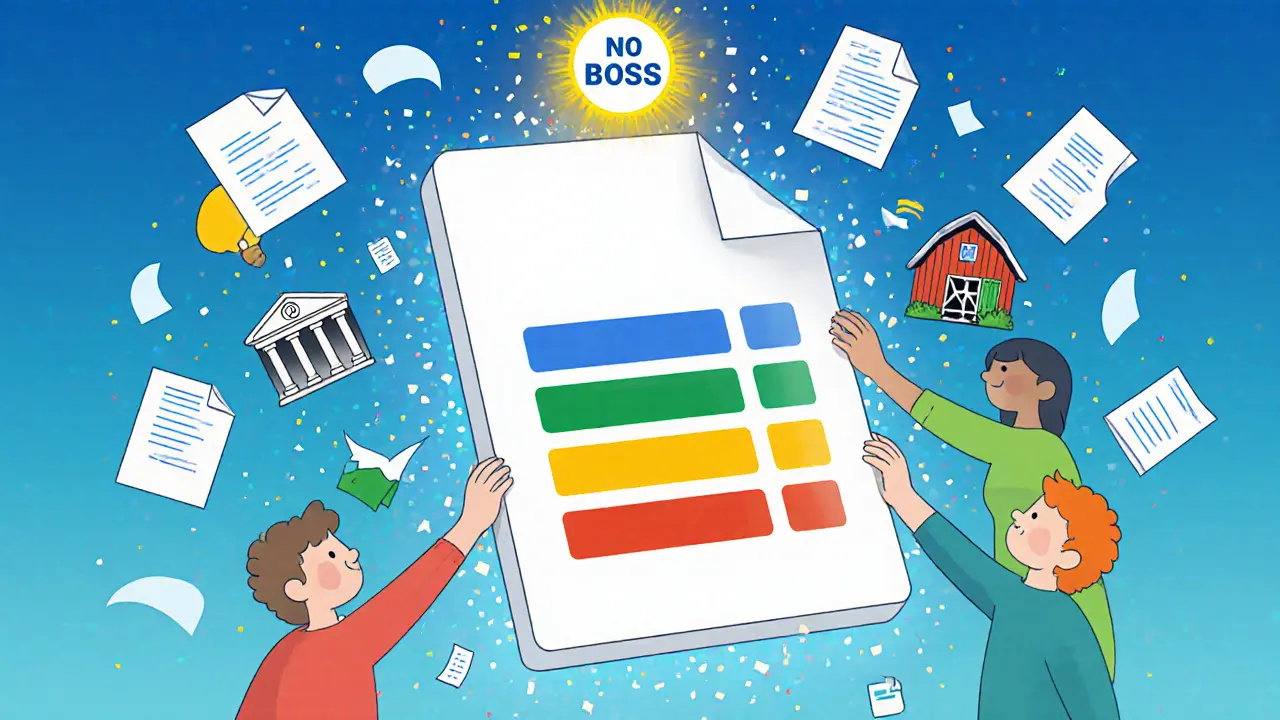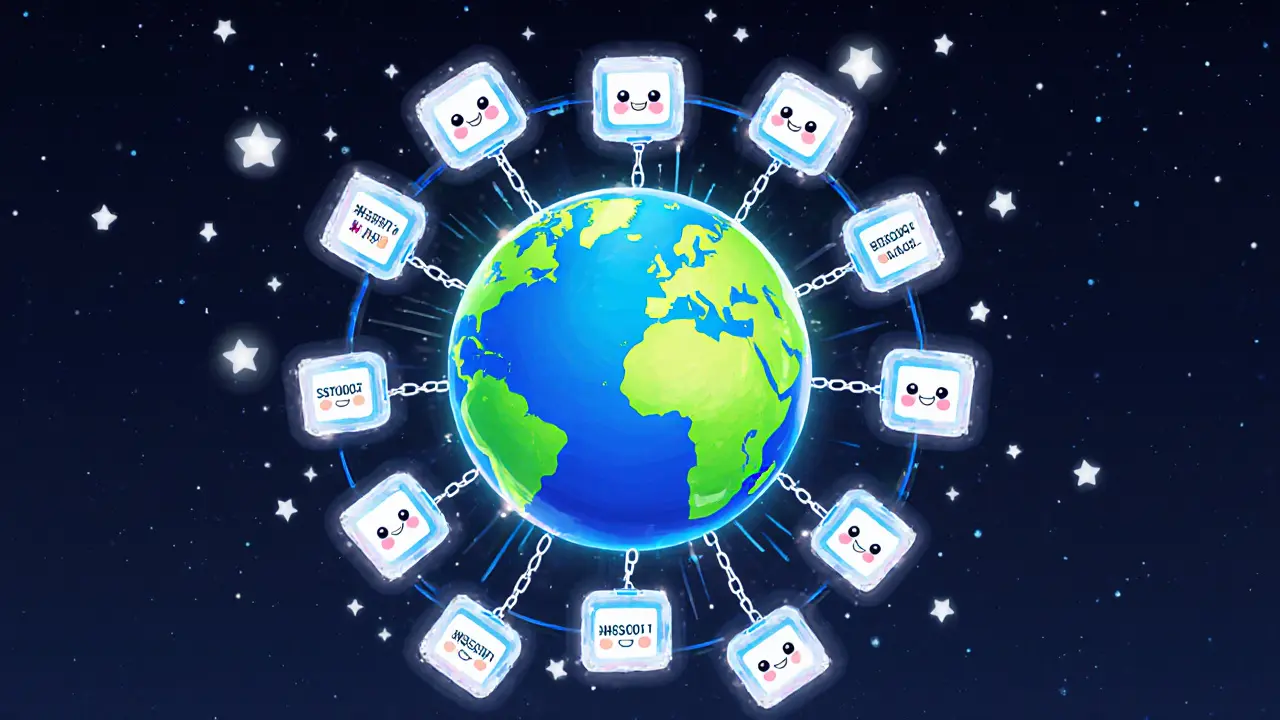
- 26 May 2025
- Elara Crowthorne
- 18
When we talk about digital ownership on blockchain is the ability to control, transfer, and monetize digital assets directly, without a middle‑man, thanks to blockchain’s immutable ledger, we’re looking at a shift from licensing to true ownership.
What exactly is digital ownership?
Traditional digital goods - a Kindle e‑book, a Spotify track, or a cloud‑stored photo - are usually sold as licenses. The platform retains the source code or file, and you merely get a permission token that can be revoked at any time. In contrast, digital ownership means the holder has full legal and technical rights to use, sell, or modify the asset as they wish.
How does blockchain make that possible?
Blockchain is a distributed ledger where every transaction is cryptographically signed and added to a chain of blocks. Once recorded, the data cannot be altered without consensus from the network, providing an immutable proof of ownership.
The process relies on three core building blocks:
- Smart contracts are self‑executing code that encode the rules of ownership, transfer, royalties, and expiration dates directly on the chain.
- Digital signatures provide mathematical proof that a transaction truly comes from the claimed owner.
- Consensus mechanisms (Proof‑of‑Work, Proof‑of‑Stake, etc.) ensure that no single party can rewrite the ledger.
Because the ledger is replicated across thousands of nodes, the ownership record is transparent, verifiable, and resistant to censorship.
Key components you should know
Here are the most common entities that appear in any digital‑ownership ecosystem:
- Non‑fungible token (NFT) - a unique, indivisible token that represents a single digital asset, like a piece of art or a virtual land parcel.
- Web3 domain - a blockchain‑based domain name (e.g., .eth, .crypto) that you control through a wallet rather than a registrar.
- Tokenization - the process of converting a real‑world or digital asset into a blockchain token, enabling fractional ownership and instant transfer.
- Decentralization - the distribution of control across many participants, eliminating a single point of failure.
- Immutability - once a block is added, its data cannot be changed without redoing the work of the entire network.
- Polkadot - a multi‑chain network that enables different blockchains to interoperate, often used for cross‑chain digital‑ownership solutions.
Real‑world use cases
From gaming to music, digital ownership is already reshaping how creators and consumers interact.
Gaming
Players now buy in‑game skins, weapons, or entire characters as NFTs. Because the items live on a blockchain, a player can sell a sword for more than the original purchase price, or even move it to a different game that supports the same token standard.
Music and Art
Artists mint their tracks or paintings as NFTs, embedding royalty logic in the smart contract. Every resale triggers an automatic payment to the original creator, a feat impossible with conventional streaming platforms.
Identity and Domains
Web3 domains let users log in to services with their crypto wallet, replacing passwords. The domain owner can update metadata, receive payments, and even host decentralized websites, all without a registrar.
Loyalty Programs
Brands are issuing token‑based loyalty points that users truly own. Unlike traditional points that can be deleted by the company, these tokens stay in the user’s wallet and can be traded on secondary markets.

Benefits of blockchain‑based ownership
Why should you care? The advantages line up nicely with the pain points of the old system.
- True control: No platform can arbitrarily revoke your rights.
- Transparency: Anyone can audit the ownership history, establishing provenance.
- Programmability: Smart contracts automate royalties, escrow, and conditional transfers.
- Interoperability: Tokens can move across compatible blockchains, opening up new markets.
- Liquidity: Fractional tokenization turns illiquid assets (e.g., a song) into tradable pieces.
Risks and how to protect yourself
While the tech removes many middle‑men, it also shifts responsibility to the holder.
- Phishing attacks: Fake approval links can trick wallets into giving away tokens. Always double‑check URLs.
- Lost private keys: Misplacing your seed phrase means losing access forever. Use hardware wallets and backup securely.
- Contract bugs: Faulty smart contracts can lock or burn assets. Look for audited code and community reviews.
- Expiration: Some Web3 domains or time‑limited NFTs require periodic renewal with crypto. Set reminders.
- Centralized governance: Certain projects let a DAO or core team freeze assets. Research governance models before buying.
Tools like Revoke.cash let you view and revoke unwanted contract permissions, while Delegate.cash helps manage delegation rights.
Traditional vs. Blockchain Digital Ownership - A quick comparison
| Aspect | Traditional Model | Blockchain Model |
|---|---|---|
| Control | Platform‑issued license, revocable at any time | Owner holds private key; control is sovereign |
| Transferability | Usually prohibited or requires platform approval | Peer‑to‑peer transfer via smart contract |
| Transparency | Opaque, data stored in proprietary databases | Public ledger shows full ownership history |
| Royalties | Manual, often absent | Automated via programmable contracts |
| Interoperability | Locked to a single ecosystem | Tokens can move across compatible blockchains |
Where is the technology headed?
Industry analysts predict that by 2027, more than half of all high‑value digital media transactions will happen on public blockchains. Expect deeper integration with AI‑generated content, where each piece of AI output is minted as an NFT with built‑in usage rights.
Enterprise adoption is also rising. Companies are tokenizing patents, software licences, and even corporate shares, turning previously illiquid assets into tradable tokens.
Getting started - Your first steps
- Set up a non‑custodial wallet (e.g., MetaMask, Trust Wallet) and safely store the seed phrase.
- Buy a small amount of the blockchain’s native token (ETH, DOT, etc.) to cover transaction fees.
- Explore reputable marketplaces (OpenSea, Rarible) and look for assets with audited smart contracts.
- If you’re an artist, consider minting on a platform that offers royalty percentages you control.
- Use Revoke.cash regularly to audit and clean up any lingering approvals.
Remember, the key is ownership, not just possession. Keep your private keys secure, verify contract code, and stay informed about governance updates.
Frequently Asked Questions
What is the difference between an NFT and a regular cryptocurrency?
Cryptocurrencies like Bitcoin are fungible - each unit is interchangeable. An NFT is unique and indivisible, representing a specific digital item or right.
Can I lose my digital assets if a blockchain network crashes?
Most major blockchains have thousands of nodes worldwide. Even if a single node fails, the network continues, so assets remain safe as long as the private key is protected.
Do I need to pay taxes on NFT sales?
Tax treatment varies by jurisdiction, but most countries consider NFT sales taxable events, either as capital gains or ordinary income.
How does a smart contract enforce royalties?
The contract includes a function that triggers on every secondary sale, automatically sending a preset percentage to the creator’s address.
What happens if I forget to renew my Web3 domain?
Most domains auto‑expire after a set period (often 365 days). If you don’t renew, the name returns to the public pool and can be claimed by anyone.
Is blockchain digital ownership secure against copying?
The original file can still be copied, but the blockchain token proves who owns the authentic version. This provenance adds value and legal weight.
Can I transfer ownership without paying gas fees?
Most public blockchains require a small fee (gas) to process transactions. Layer‑2 solutions and sidechains can reduce these costs dramatically.



18 Comments
Digital ownership flips the script on who actually controls your stuff.
Understanding blockchain's role in digital ownership begins with recognizing that trust is no longer delegated to a single corporation but is instead embedded in cryptographic proofs that anyone can verify.
When you mint an NFT, the smart contract records not just the asset's metadata but also the immutable proof that you, and only you, hold the private key that grants you authority over that token.
This shift means that royalties are no longer a hopeful guess by platforms; they become enforceable code that automatically routes a percentage of every resale to the original creator's wallet.
Moreover, because the ledger is distributed across thousands of nodes, the history of ownership is transparent, allowing collectors to trace provenance with the same certainty as tracing a physical painting's lineage.
From a practical standpoint, setting up a non‑custodial wallet like MetaMask is the first step; it hands you the private key, which is the linchpin of sovereignty in this new paradigm.
Once you have the wallet, acquiring a modest amount of the network's native token-ETH for Ethereum, DOT for Polkadot-covers gas fees, which are the transaction costs inherent to recording your ownership change on-chain.
Exploring marketplaces that prioritize audited contracts, such as OpenSea's verified collections, further mitigates the risk of falling prey to malicious code that could lock or burn assets.
In addition, tools like Revoke.cash let you audit and revoke lingering approvals, ensuring that no rogue contract retains unlimited spending rights over your assets.
For creators, minting on platforms that allow you to set royalty percentages empowers you to earn passive income long after the initial sale, turning the creative process into a sustainable revenue model.
On the consumer side, this model introduces true liquidity; NFTs can be traded on secondary markets without needing platform permission, and fractionalization technologies enable investors to own slices of high‑value assets.
The interoperability promise is also noteworthy-cross‑chain bridges and standards like ERC‑721 or ERC‑1155 allow assets to move between compatible blockchains, expanding the ecosystem beyond a single silo.
Nevertheless, this empowerment comes with responsibility: safeguarding your seed phrase is paramount, as loss equals permanent loss of access.
Similarly, staying vigilant about contract audits and community reviews safeguards against hidden backdoors that could jeopardize your holdings.
In summary, blockchain transforms digital ownership from a fragile license into a verifiable, programmable, and transferable right, but it demands that users adopt new security habits and a mindset of active stewardship.
If you think this whole blockchain thing magically fixes every problem, think again-most folks still get scammed.
People still fall for phishing links that look legit but just steal your private key.
Also, not every NFT is a masterpiece; many are just meme junk that nobody really wants.
So yeah, do your homework before you drop cash into a smart contract.
Great point on how NFTs can embed royalties; that’s a game‑changer for artists who struggle with streaming payouts.
Having a transparent chain of ownership also helps fight plagiarism because you can always point to the token as proof.
Just remember that the underlying file can still be copied; the token just tells you who the official owner is.
Using tools like OpenSea’s verification badge adds an extra layer of trust for buyers.
Overall, the blend of creativity and code opens up exciting pathways for both creators and collectors.
Look, the whole “decentralized” hype masks the fact that a few big players still control the narrative.
Every time you rely on a popular marketplace, you’re handing them a massive amount of data about your buying habits.
And don’t forget the hidden gas fees that keep trending higher, squeezing out the little‑time investors.
On top of that, there are secret governance votes where a small council can freeze or burn tokens without a public reason.
So while the promise of true ownership sounds noble, the reality is that power structures keep morphing into new shapes, just under a different name.
Stay cautious, read the fine print of any DAO, and remember that anonymity doesn’t equal safety.
Yo, the drama around NFTs is straight up theatrical, but when you actually own a piece, the brag factor is real.
The hype can be toxic, yet the utility of having a token you can sell next week is legit.
Just watch out for the “gotcha” contracts that lock your art forever.
Honestly, the key takeaway: secure your seed phrase, because losing it = losing everything, period.
Also, double‑check any approval prompt before you click “confirm,” it could be a trap.
👍 Absolutely love how smart contracts automate royalties; it’s like getting a paycheck every time your art changes hands! 🚀
Having that built‑in safety net makes the whole NFT ecosystem feel way more trustworthy.
Blockchain gives you actual control, not just a license that can be pulled.
The ledger is public, so you can always see who owned what and when.
Just make sure to back up your seed phrase in a safe place.
That’s the basics for staying secure.
When you think about ownership as a philosophical concept, the blockchain actually externalizes agency.
It shifts the locus of control from a corporate gatekeeper to the individual holder.
This raises interesting questions about what it means to truly possess a digital artifact.
In practice, the clarity of the blockchain record simplifies disputes, which is a pragmatic benefit.
Listen, if you ignore the contract audit, you’re basically handing over your wallet to a stranger.
Even a well‑written contract can have a hidden backdoor if the devs are sloppy.
So always verify the code or rely on community‑vetted contracts.
This isn’t just advice; it’s essential for protecting your assets.
And don’t forget to use Revoke.cash to clean up old approvals.
Yo, the NFT space is wild, but most of the glitter is just hype.
If you’re not careful, you’ll end up paying big fees for nothing.
Stick to verified collections and keep an eye on the gas price.
That’ll save you a lot of headaches.
Security is key; never share your seed phrase with anyone.
Use hardware wallets for large holdings.
Regularly audit your token approvals.
When I first minted my art, the excitement was off the charts.
The moment the transaction confirmed, I felt like I owned a piece of the future.
Seeing the royalty automatically flow to my wallet on each resale is pure magic.
It’s not just about the money; it’s about being recognized every time the piece changes hands.
That sense of perpetual connection with your work is something traditional platforms can’t offer.
So for creators, this tech isn’t a gimmick-it’s a genuine empowerment tool.
Everyone’s raving about NFTs, but let’s not pretend it’s all rainbows.
There are legitimate concerns about environmental impact and market speculation.
Still, the utility of programmable ownership can’t be dismissed.
Just stay critical and do your own research.
Yo, keep it real-if you’re not comfortable with the tech, don’t jump in.
Start small, maybe buy a cheap NFT just to learn the ropes.
Watch the gas fees and make sure you’ve got a backup of your seed phrase.
And don’t get fooled by flashy marketing; always check the contract code.
That way you’ll avoid getting burned early on.
Don, the idea that “anyone can verify ownership” is a nice line, but in reality, most users lack the technical skill to do it.
Moreover, the anonymity of blockchain can enable illicit activities, which is a moral hazard.
Regulators are already looking at ways to force KYC on wallet owners.
If that happens, the whole promise of decentralized ownership could crumble.
Stay skeptical and keep an eye on policy developments.
It is noteworthy that, whilst the cryptographic underpinnings of blockchain confer an aura of invulnerability, the practical implementation of smart contracts is frequently plagued by vulnerabilities arising from inadequate formal verification, thereby engendering a latent risk of systemic exploitation.
Consequently, a rigorous audit regime, preferably conducted by multiple independent security firms, should be deemed a prerequisite prior to any substantial capital allocation.
Additionally, the ostensible decentralization is often compromised by the concentration of mining power or staking influence within a limited cadre of entities, which may subtly dictate consensus outcomes.
These factors collectively necessitate a tempered enthusiasm, lest one be ensnared by speculative fervor unaccompanied by due diligence.
In summary, while the theoretical framework is sound, operational prudence remains paramount.